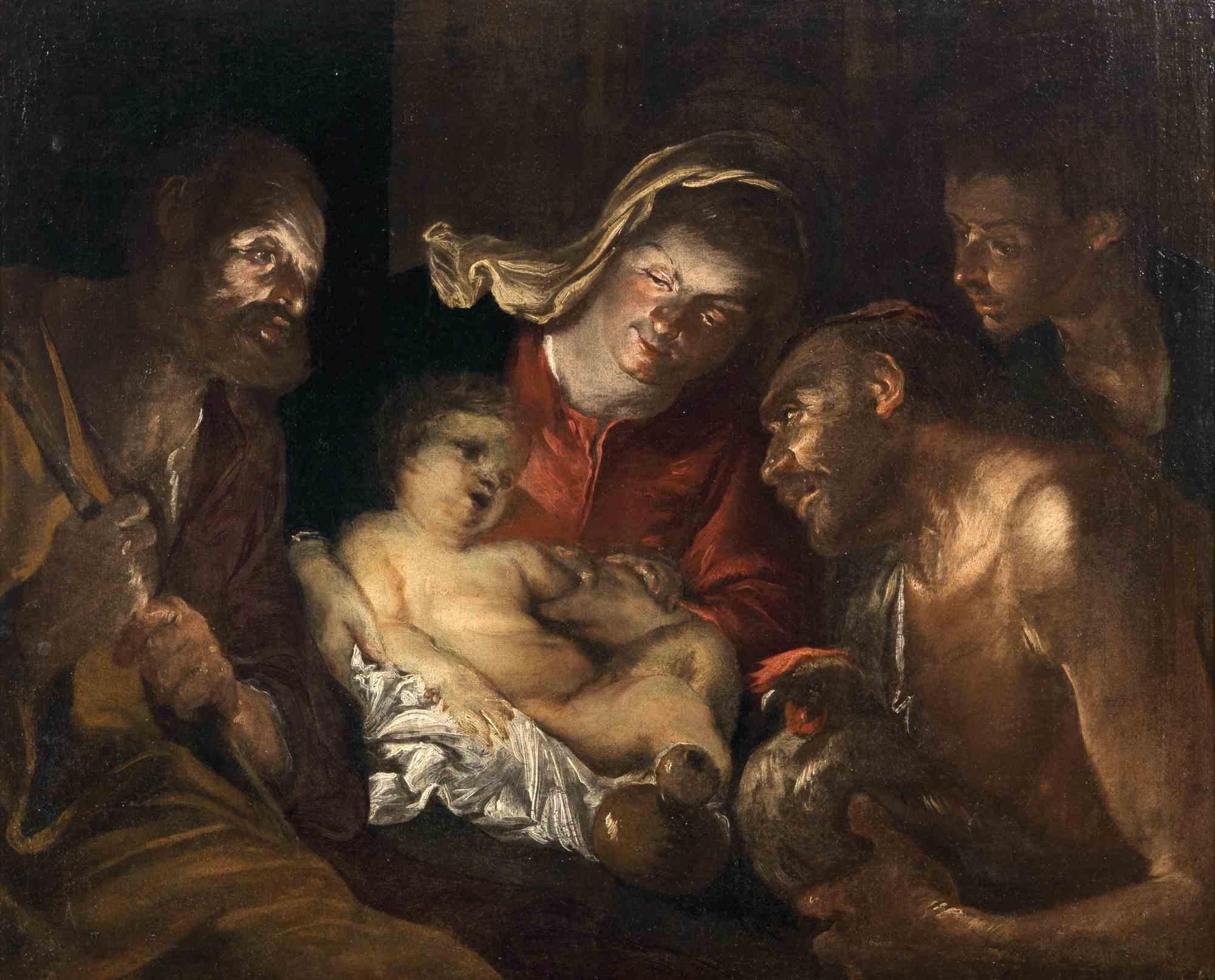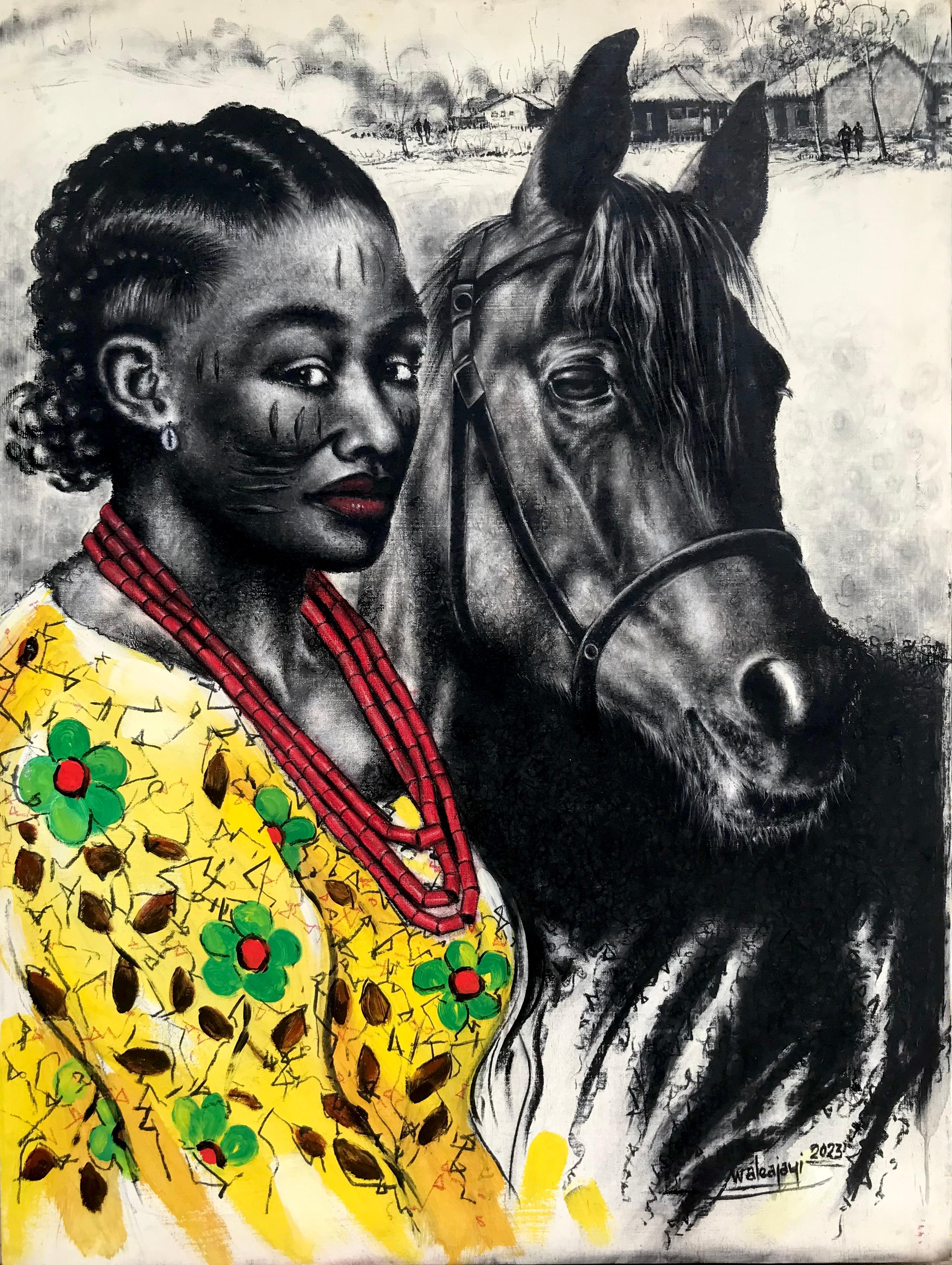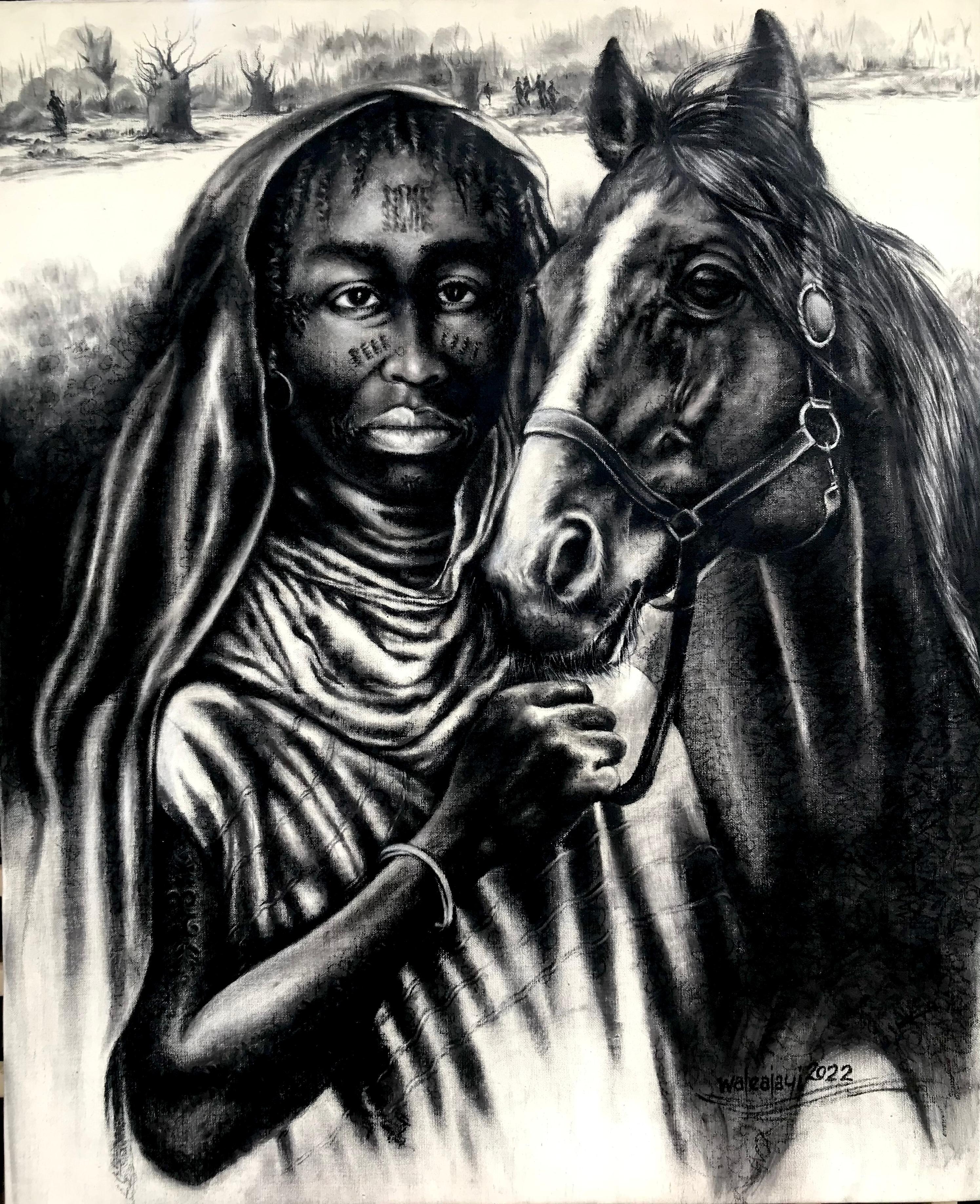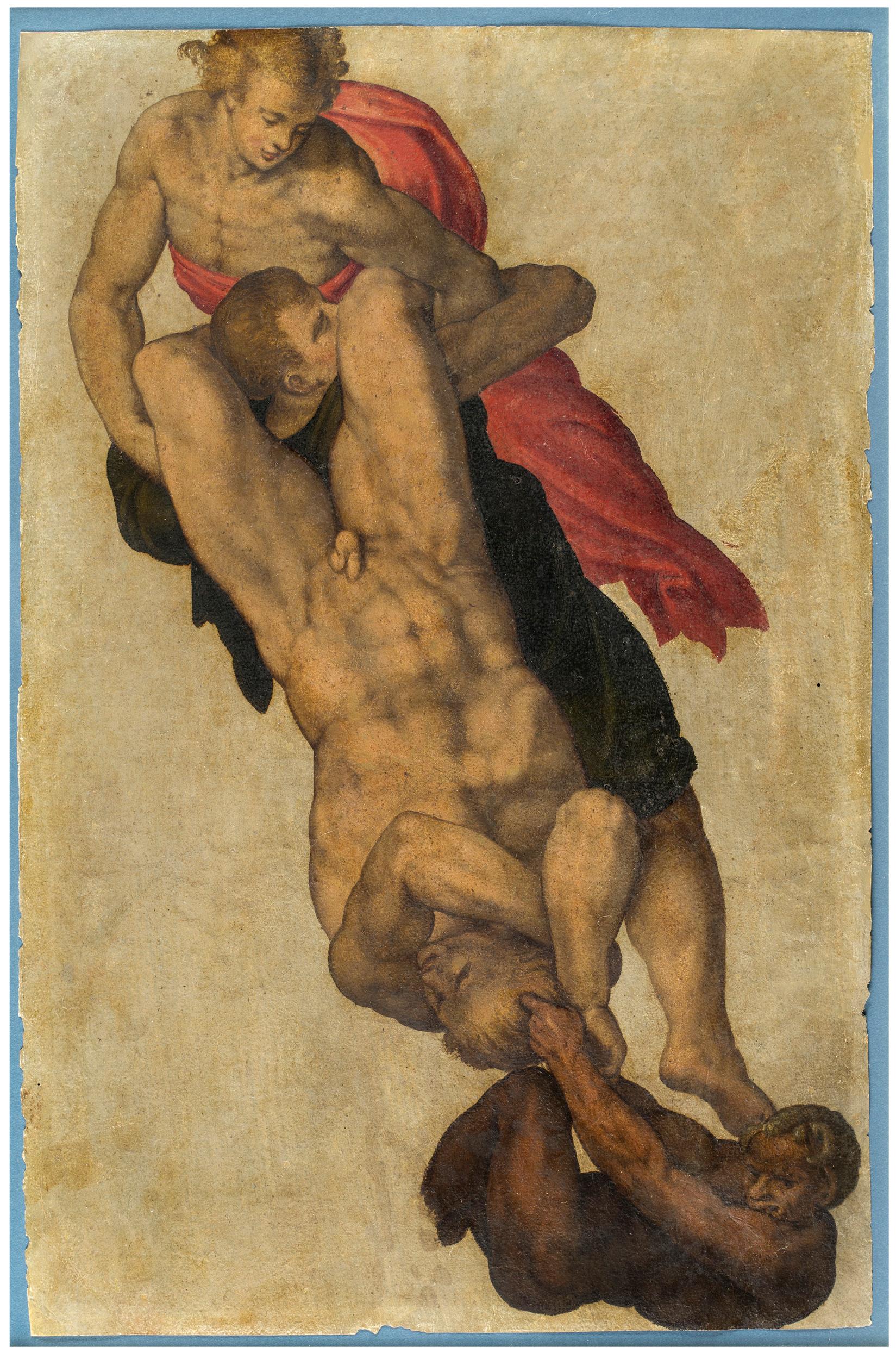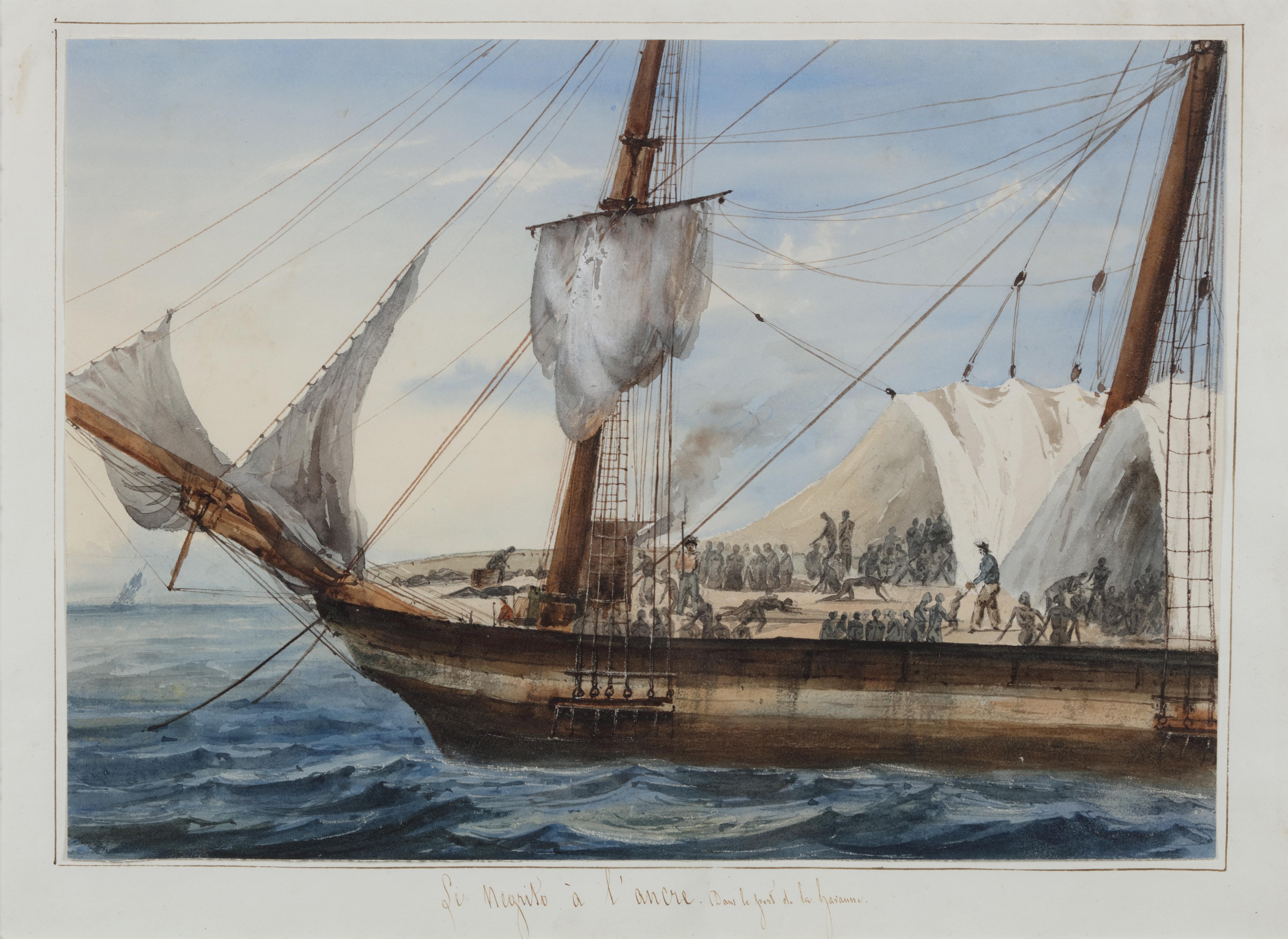Items Similar to Judith and Salome, a pair of oil paintings on canvas by Francesco Conti
Want more images or videos?
Request additional images or videos from the seller
1 of 19
Francesco ContiJudith and Salome, a pair of oil paintings on canvas by Francesco Conticirca 1710-1720
circa 1710-1720
About the Item
This widely referenced pair of paintings is one of Francesco Conti’s most successful productions. Francesco Conti is one of the finest painters of 18th-century Florence. In the shimmering colors typical of his best work, he represents two opposite characters from the Bible: the virtuous Judith, whose courage saves her people by cutting off the head of the invader Holofernes, and the depraved Salome, who under the influence of her mother becomes responsible for the beheading of the prophet John the Baptist.
The artist's talent lies in his ability to treat these two macabre subjects with a light touch, presenting us with two attractive women who seem to twirl with glee amidst the severed heads...
1. Francesco Conti, the “Florentine Tiepolo”
Francesco Conti is a major painter of the Florentine school of the 18th century; he can even probably be considered, along with Giovanni Domenico Ferretti (1692-1768), as one of the two main painters of the second quarter of the Florentine 18th century.
Born in Florence in 1682, Francesco Conti began his apprenticeship in the workshop of Simone Pignoni (1611 - 1698), a disciple of Francesco Furini; he was also influenced by the Venetian Sebastiano Ricci. A protégé of Marquis Riccardi, he accompanied him to Rome between 1699 and 1705, where he frequented Carlo Maratta's studio. He settled permanently in Florence in 1705.
Painted exclusively on canvas, the majority of his work consists of religious subjects, altarpieces or private devotional works. It is likely that Conti himself was a devout churchgoer, as evidenced by his affiliation, in the third decade of the eighteenth century, to the Society of the Disciples of Saint-John-the-Baptist, and his entry, at the end of his life, into the fraternity of the Venerable Society of the Holy Trinity.
In Florence, Conti worked for the Grand Duchy's major patrons, including the last Medici - in particular Giangastone and Annamaria Luisa, Electress Palatine - and confirmed his role as a reference painter under the Lorraine Regency, as master of the Public Drawing School, which was closely linked to the institute responsible for the manufacture of semi-precious stone mosaics, then located in the Uffizi complex.
Matteo Marangoni, an art critic of the early 20th century, praised his "brushwork full of elegance and true spirit of the 18th century", pointing out that Conti was "probably one of the best colorists" of the Florentine school of his time. These two characteristics led the art historian Paolo dal Poggetto to nickname him the "Florentine Tiepolo".
2. Judith and Salome, two biblical characters opposing each other
These two paintings form a pair presenting two biblical episodes, which have in common the depiction of a "heroine" carrying the severed head of a man.
While the Salome episode might at first appear to be an echo of the Old Testament story of Judith, each character is the exact opposite of the other. Judith, whose story is told in the Book of Judith, is a beautiful young widow from Bethulia who, accompanied by her maid, went into the camp of the invading Assyrians and won the confidence of Holofernes, the general commanding the enemy army. Invited to a great feast on the fourth evening, she took advantage of Holofernes' drunkenness to cut off his head. “She went up to the bedpost near Holofernes’ head, and took down his sword that hung there. She came close to his bed, took hold of the hair of his head, and said, “Give me strength today, O Lord God of Israel!” Then she struck his neck twice with all her might, and cut off his head. Next she rolled his body off the bed and pulled down the canopy from the posts. Soon afterward she went out and gave Holofernes’ head to her maid, who placed it in her food bag. Then the two of them went out together, as they were accustomed to do for prayer. They passed through the camp, circled around the valley, and went up the mountain to Bethulia, and came to its gates. ” Judith is therefore a model of a strong, deeply religious woman whose courageous action liberates her people and leads them to victory over the invaders.
Salome's character is the exact opposite of Judith's. She is the daughter of Herodias, who left her first husband to marry his brother Herod Antipas. The story of the fateful banquet is recounted in the Gospels according to St. Mark and St. Matthew: " Now Herod had arrested John and bound him and put him in prison because of Herodias, his brother Philip’s wife, for John had been saying to him: “It is not lawful for you to have her.” Herod wanted to kill John, but he was afraid of the people, because they considered John a prophet. On Herod’s birthday the daughter of Herodias danced for the guests and pleased Herod so much that he promised with an oath to give her whatever she asked. Prompted by her mother, she said, “Give me here on a platter the head of John the Baptist.” The king was distressed, but because of his oaths and his dinner guests, he ordered that her request be granted and had John beheaded in the prison. His head was brought in on a platter and given to the girl, who carried it to her mother." Salome is just a child living in a depraved court; she obtains the beheading of a man driven by her mother, to satisfy her whim.
3. Description of the artworks
Judith is depicted in mid-body, her face festooned and her body adorned in her finest finery. The shimmering colors evoke a luminous triumph. With her right hand, she leans on the sword with which she has just severed Holofernes' head, and with her left hand, she brandishes his head, holding it by the hair. Her maid, crouching on the lower right, opens her food bag to collect the severed head.
The angular folds of the maid's clothing are characteristic of Francesco Conti's early artworks, such as his Ascension of the Virgin and Christ in the Garden. They suggest that these paintings were probably produced in the second decade of the eighteenth century.
Salome is also depicted as a woman rather than a young girl. As she advances to bring the dish containing the prophet's head to her mother, she turns to face the guard who has decapitated St. John the Baptist, as suggested by the sword held in his firm hand. The swirl of red cloth surrounding her, which could have an evil connotation, accompanies her moving body. The composition, featuring a cellar lit vertically by an oculus, could be inspired by Titian's Ecce Homo (last photo in the gallery).
The triangle formed by the three heads (Salome's head, which seems to turn towards the guard, and her arm, which guides our gaze from the guard to the head of Saint John the Baptist, whose eyes are closed, but who nevertheless seems to be staring at Salome) is particularly successful and masterly painted.
The presence of feathers in the hairstyles of these two women is also a particularly charming detail: marks of light-hearted coquetry, these feathers contrast with the macabre character of the two episodes depicted and are one of the most representative details of the neo-Mannerist treatment offered here.
These two paintings have been identified as two important works of Francesco Conti since the work of Sonia Meloni Trkulja, which led to renewed interest in Conti's work in the 1980s, as evidenced by the large number of publications in which they appear.
The quality of these two paintings, their singularity in the artist's oeuvre and the limited representation of this important Florentine artist in the Uffizi Gallery's collections (which only include his self-portrait and two artworks in darker colors, a Crucifixion and a Way of Calvary) had led the Gallery to consider their acquisition when the export license for these two works was issued. In the end, this acquisition did not materialize, which means that we can now present them for the first-time outside Italy.
4. Framing
We have chosen a pair of 18th-century Italian frames from the Marche region to frame this pair of paintings.
Literature :
S. Meloni Trkulja - Conti, Francesco in Dizionario Biografica degli Italiani, XXVIII (1983), Roma page 402
S. Meloni Trkulja - Francesco Conti illustrato, Arte Cristiana, 707 (1985) pages 85-86
S. Meloni Trkulja - Conti, Francesco in LA PITTURA (1990), II, page 678
Concept 1995 - Concept of a collection 1650-1994, Donatella Mei, Rivka Rinn - Montespertoli (FI) - pages 6, 30, 32
F. Berti - Francesco Conti pittore fiorentino (tesi di Laurea, Università degli Studi di Firenze 1996-1997) page 84
S. Bellesi - Catalogo dei pittori fiorentini del '600 e '700 - (2009) Firenze I page 113
F. Berti - Francesco Conti - (2010) Edifir Edizioni Firenze pages 134- 135
- Creator:Francesco Conti (1682 - 1760, Italian)
- Creation Year:circa 1710-1720
- Dimensions:Height: 26.88 in (68.28 cm)Width: 22.5 in (57.15 cm)
- Medium:
- Movement & Style:
- Period:1710-1719
- Condition:Dimensions: 26 7/8’’ x 22 ½’’ (68.2 x 57.2 cm) - Framed: 32 7/8’’ x 28 3/8’’ (83.5 x 72 cm) Provenance: Guidi collection, Florence Framing: carved and gilded wooden frames with floral scrolls - Italy, Marche region - 18th century.
- Gallery Location:PARIS, FR
- Reference Number:1stDibs: LU1568214022052
About the Seller
5.0
Vetted Seller
These experienced sellers undergo a comprehensive evaluation by our team of in-house experts.
Established in 2020
1stDibs seller since 2021
8 sales on 1stDibs
Typical response time: 1 hour
- ShippingRetrieving quote...Ships From: PARIS, France
- Return PolicyA return for this item may be initiated within 3 days of delivery.
More From This SellerView All
- The Abduction of the Sabine Women , a Renaissance drawing by Biagio PupiniLocated in PARIS, FRThis vigorous drawing has long been attributed to Polidoro da Caravaggio: The Abduction of the Sabine Women is one of the scenes that Polidoro depicted between 1525 and 1527 on the façade of the Milesi Palazzo in Rome. However, the proximity to another drawing inspired by this same façade, kept at the Ecole des Beaux-Arts, and to other drawings inspired by Polidoro kept at the Musée du Louvre, leads us to propose an attribution to Biagio Pupini, a Bolognese artist whose life remains barely known, despite the abundant number of drawings attributed to him. 1. Biagio Pupini, a Bolognese artist in the light of the Roman Renaissance The early life of Biagio Pupini, an important figure of the first half of the Cinquecento in Bologna - Vasari mentions him several times - is still poorly known. Neither his date of birth (probably around 1490-1495) nor his training are known. He is said to have been a pupil of Francesco Francia (1450 - 1517) and his name appears for the first time in 1511 in a contract with the painter Bagnacavallo (c. 1484 - 1542) for the frescoes of a church in Faenza. He then collaborated with Girolamo da Carpi, at San Michele in Bosco and at the villa of Belriguardo. He must have gone to Rome for the first time with Bagnacavallo between 1511 and 1519. There he discovered the art of Raphael, with whom he might have worked, and that of Polidoro da Caravaggio. This first visit, and those that followed, were the occasion for an intense study of ancient and modern art, as illustrated by his abundant graphic production. Polidoro da Caravaggio had a particular influence on the technique adopted by Pupini. Executed on coloured paper, his drawings generally combine pen, brown ink and wash with abundant highlights of white gouache, as in the drawing presented here. 2. The Abduction of the Sabine Women Our drawing is an adaptation of a fresco painted between 1525 and 1527 by Polidoro da Caravaggio on the façade of the Milesi Palace in Rome. These painted façades were very famous from the moment they were painted and inspired many artists during their stay in Rome. These frescoes are now very deteriorated and difficult to see, as the palace is in a rather narrow street. The episode of the abduction of the Sabine women (which appears in the centre of the photo above) is a historical theme that goes back to the origins of Rome and is recounted both by Titus Livius (Ab Urbe condita I,13), by Ovid (Fasti III, 199-228) and by Plutarch (II, Romulus 14-19). After killing his twin brother Romus, Romulus populates the city of Rome by opening it up to refugees and brigands and finds himself with an excess of men. Because of their reputation, none of the inhabitants of the neighbouring cities want to give them their daughters in marriage. The Romans then decide to invite their Sabine neighbours to a great feast during which they slaughter the Sabines and kidnap their daughters. The engraving made by Giovanni Battista Gallestruzzi (1618 - 1677) around 1656-1658 gives us a good understanding of the Polidoro fresco, allowing us to see how Biagio Pupini reworked the scene to extract this dynamic group. With a remarkable economy of means, Biagio Pupini takes over the left-hand side of the fresco and depicts in a very dense space two main groups, each consisting of a Roman and a Sabine, completed by a group of three soldiers in the background (which seems to differ quite significantly from Polidoro's composition). The balance of the drawing is based on a very strongly structured composition. The drawing is organised around a median vertical axis, which runs along both the elbow of the kidnapped Sabine on the left and the foot of her captor, and the two main diagonals, reinforced by four secondary diagonals. This diamond-shaped structure creates an extremely dynamic space, in which centripetal movements (the legs of the Sabine on the right, the arm of the soldier on the back at the top right) and centrifugal movements (the arm of the kidnapper on the left and the legs of the Sabine he is carrying away, the arm of the Sabine on the right) oppose each other, giving the drawing the appearance of a whirlpool around a central point of support situated slightly to the left of the navel of the kidnapper on the right. 3. Polidoro da Caravaggio, and the decorations of Roman palaces Polidoro da Caravaggio was a paradoxical artist who entered Raphael's (1483 - 1520) workshop at a very young age, when he oversaw the Lodges in the Vatican. Most of his Roman work, which was the peak of his career, has disappeared, as he specialised in facade painting, and yet these paintings, which are eminently visible in urban spaces, have influenced generations of artists who copied them abundantly during their visits to Rome. Polidoro Caldara was born in Caravaggio around 1495-1500 (the birthplace of Michelangelo Merisi, known as Caravaggio, who was born there in 1571), some forty kilometres east of Milan. According to Vasari, he arrived as a mason on the Vatican's construction site and joined Raphael's workshop around 1517 (at the age of eighteen according to Vasari). This integration would have allowed Polidoro to work not only on the frescoes of the Lodges, but also on some of the frescoes of the Chambers, as well as on the flat of Cardinal Bibiena in the Vatican. After Raphael's death in 1520, Polidoro worked first with Perin del Vaga before joining forces with Maturino of Florence (1490 - 1528), whom he had also known in Raphael's workshop. Together they specialised in the painting of palace façades. They were to produce some forty façades decorated with grisaille paintings imitating antique bas-reliefs. The Sack of Rome in 1527, during which his friend Maturino was killed, led Polidoro to flee first to Naples (where he had already stayed in 1523), then to Messina. It was while he was preparing his return to the peninsula that he was murdered by one of his assistants, Tonno Calabrese, in 1543. In his Vite, Vasari celebrated Polidoro as the greatest façade decorator of his time, noting that "there is no flat, palace, garden or villa in Rome that does not contain a work by Polidoro". Polidoro's facade decorations, most of which have disappeared as they were displayed in the open air, constitute the most important lost chapter of Roman art of the Cinquecento. The few surviving drawings of the painter can, however, give an idea of the original appearance of his murals and show that he was an artist of remarkable and highly original genius. 4. The façade of the Milesi Palace Giovanni Antonio Milesi, who commissioned this palace, located not far from the Tiber, north of Piazza Navona, was a native of the Bergamo area, like Polidoro, with whom he maintained close friendly ties. Executed in the last years before the Sack of Rome, around 1526-1527, the decoration of Palazzo Milesi is considered Polidoro's greatest decorative success. An engraving by Ernesto Maccari made at the end of the nineteenth century allows us to understand the general balance of this façade, which was still well preserved at the time. The frescoes were not entirely monochrome, but alternated elements in chiaroscuro simulating marble bas-reliefs and those in ochre simulating bronze and gold vases...Category
16th Century Old Masters Figurative Drawings and Watercolors
MaterialsInk, Gouache, Pen
- Study for a Frontispiece, a baroque drawing by Giovanni Antonio PellegriniBy Giovanni Antonio PellegriniLocated in PARIS, FRThis masterly frontispiece study, executed with a very sure hand, testifies to the survival of the great Baroque taste in 18th century Venice. It could be one of the very last works by Giovanni Antonio Pellegrini: the few lines that cross the papal arms evoke those of Benedict XIV, who became pope in 1740, one year before the artist's death. 1. Giovanni Antonio Pellegrini and the European influence of Venetian history painting in the 18th century Giovanni Antonio Pellegrini was born in Venice in 1675 and trained in the studio of the Milanese painter Paolo Pagani (1655 - 1716). Pagani, who had been living in Venice since 1667, took him to Moravia and Vienna from 1690 to 1696. After a stay in Rome from 1699 to 1701, Pellegrini married Angiola Carriera in 1704, the sister of the great pastelist Rosalba Carriera. From 1708 onwards, Pellegrini left Venice and began an extensive tour of Europe: he worked in England between 1708 and 1713, where he met great success, particularly at Kimbolton Castle and Castle Howard. He then worked in Germany and the Netherlands, then in Bohemia and Austria, before returning briefly to England in 1719. In 1720 he was in Paris where he decorated the ceilings of the Royal Bank for John Law...Category
1740s Old Masters Figurative Drawings and Watercolors
MaterialsInk
- The Martyrdom of Saint Bartholomew, a preparatory drawing by Alessandro CasolaniLocated in PARIS, FRThis powerful pen and brown ink wash drawing is a study for an altarpiece depicting The Martyrdom of Saint Bartholomew. Signed and dated 1604, it was painted at the end of his life b...Category
Early 1600s Old Masters Figurative Drawings and Watercolors
MaterialsInk, Pen
- Portrait of a Lady, Drawing Signed and Dated by Augustin de Saint-AubinBy Augustin de Saint-AubinLocated in PARIS, FRThis drawing full of freshness presents us with the profile of an elegant lady, drawn by Augustin de Saint-Aubin on a beautiful summer day in 1776, during the early months of Louis X...Category
1770s Old Masters Portrait Drawings and Watercolors
MaterialsPastel, Pencil
- The Arab Butcher, a preparatory drawing by Gustave Guillaumet (1840 - 1887)Located in PARIS, FRThis intensely expressive figure is a preparatory study for "Arab Market on the Tocria Plain", a painting exhibited at the 1865 Salon and now in the Musée des Beaux-Arts in Lille. 1...Category
1860s Old Masters Figurative Drawings and Watercolors
MaterialsChalk, Carbon Pencil
- A dazzling Venetian Regatta Boat Study attributed to Alessandra MauroLocated in PARIS, FRThis stunning Baroque study depicts a regatta boat, a type of vessel developed in eighteenth-century Venice for the regattas organized by the Serenissima during visits by royalty and...Category
Mid-18th Century Old Masters Figurative Drawings and Watercolors
MaterialsChalk
You May Also Like
- Drawing Ink 16th 17th Flemish DE VOS Religious Martyrdom of James The GreatLocated in PARIS, FRFlemish school from the beginning of the 17th century (Circle of Martin DE VOS) Drawing Pen and wash 38 x 32 cm (58 x 52 cm with the frame) Inscription "Martin de Vos" Excellent cond...Category
Early 17th Century Old Masters Figurative Drawings and Watercolors
MaterialsOil
- The Adoration -Painting by Giuseppe Assereto - 1630By Giuseppe AsseretoLocated in Roma, ITThe Adoration is an original modern artwork realized by Giuseppe Assereto (died in Genoa in 1650) in the first half of the 17th Century. Original Oil Painting on Canvas. A 19th Century style gilded wood frame is included. The Autograph of the work was confirmed by Camillo Manzitti. Very good conditions. The frame is in excellent conditions too. Reference: C. Marcenaro, Pittori genovesi a Genova nel '600 e nel '700, Genova 1969, pp. 134 ; 135, n. 55. Z. Wazbinski, Un Quadro Caravaggesco Di Gioacchino Assereto, in Prospettiva, n. 26, 1981, pp. 60 ; 63. F. R. Pesenti, La Pittura in Liguria. Artisti del primo Seicento, Genova 1986, p. 397, nota 23. A. Gesino, Tracce di Matthias Stom nel collezionismo tra la Sicilia e Genova, in Caravaggio e i genovesi, catalogo della Mostra a cura di A. Orlando, Genova 2019, pp. 182 ; 195. The Adoration is an excellent example of the XVII Century Italian Painting. The style of the work denotes the suggestive influence of Assereto father's mature production, when influenced by Mathias Stom (Amersfoort, about 1600 - Sicily, after 1650) expresses dark sensibilities in a southern Italian style. In his works, however, there is an accentuated naturalism and interesting similarities with the production of Giovanni Benedetto Castiglione. Gioacchino Assereto died in 1650, while, according to Soprani, he was intent on painting a Last Supper for the oratory...Category
1630s Old Masters Figurative Drawings and Watercolors
MaterialsOil
- Ayanfe Omo ObaLocated in Ibadan, OyoThe drawings showcase the beauty of the black women on one hand and also reflect the intimacy animals possess with females, especially horses, and princesses in royalty. They are muc...Category
21st Century and Contemporary Old Masters Figurative Drawings and Waterc...
MaterialsCanvas, Charcoal
- Princess from the SavannahLocated in Ibadan, OyoThe drawings showcase the beauty of the black women on one hand and also reflect the intimacy animals possess with females, especially horses, and princesses in royalty. They are muc...Category
21st Century and Contemporary Old Masters Figurative Drawings and Waterc...
MaterialsCanvas, Charcoal
- Study after Michelangelo’s “The Last Judgment”By Michelangelo BuonarrotiLocated in New York, NYItalian School, 16th Century Provenance: Private Collection, New York This intriguing drawing is a study by an anonymous 16th-century Italian artist after a vignette in Michelangelo’s fresco of The Last Judgement in the Sistine Chapel. The altar wall of the Sistine Chapel was already richly decorated when Pope Clement VII commissioned Michelangelo to paint his Last Judgment...Category
16th Century Old Masters Figurative Drawings and Watercolors
MaterialsGouache, Paper
- Portrait of a Slave Ship: 'Le Negrito à l’ancre. Dans le port de la havanne'Located in Amsterdam, NLFRANÇOIS MATHURIN ADALBERT, BARON DE COURCY (1805-1839) 'Le Negrito à l’ancre. Dans le port de la havanne' Indistinctly signed lower left Titled on the mount Pencil and watercolour, heightened with white, on paper, 24.8 x 34.6 cm Literature: The present watercolour will be illustrated in: - Prof. Manuel Garcia’s projected book on the disease and the slave trade provisionally titled “Fighting the Yellow Demon of Fever: The Struggle against Disease in the Illegal Slave Trade”. - Prof. Micael Zeuske’s forthcoming Global history of slave trade. Exhibited: Mexico City, 1998, Palacio Virreinal, El Barón de Courcy, illustrationes de un viaje, 1831-1833, no. 108 Note: Baron de Courcy was in the Caribbean in late 1832 and early 1833, following his tour of Mexico in 1832, on the last leg of his “Grand Voyage...Category
Mid-19th Century Old Masters Figurative Drawings and Watercolors
MaterialsWatercolor, Paper, Gouache, Pencil
Recently Viewed
View AllMore Ways To Browse
Cellar Master
Pair Of Oil Paintings
Pair Of Oil On Canvas
Mother And Daughter Painting
On Hold Means
Man And Woman Oil Painting
Pair Of Oil On Canvas Framed
Pair Of Framed Oil Paintings On Canvas
Old Man And Woman
John John Florence
Pair Antique Oil On Canvas
Old Man Face
Master E S
Biblical Drawings
Womans And Mans Face
Pair Of Old Masters
Oil Paintings Of Mother And Daughter
Pair Of Large Oil Paintings

